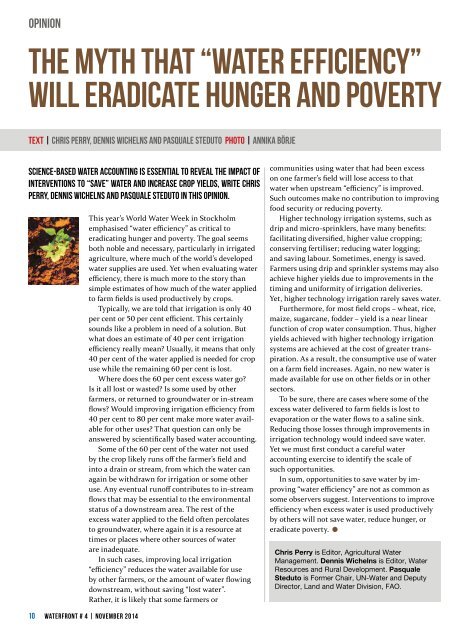Waterfront, #4, November 2014
You also want an ePaper? Increase the reach of your titles
YUMPU automatically turns print PDFs into web optimized ePapers that Google loves.
OPINION<br />
THE MYTH THAT “WATER EFFICIENCY”<br />
WILL ERADICATE HUNGER AND POVERTY<br />
TEXT | Chris Perry, Dennis Wichelns and Pasquale Steduto PHOTO | Annika börje<br />
Science-based water accounting is essential to reveal the impact of<br />
interventions to “save” water and increase crop yields, write Chris<br />
Perry, Dennis Wichelns and Pasquale Steduto in this opinion.<br />
This year’s World Water Week in Stockholm<br />
emphasised “water efficiency” as critical to<br />
eradicating hunger and poverty. The goal seems<br />
both noble and necessary, particularly in irrigated<br />
agriculture, where much of the world’s developed<br />
water supplies are used. Yet when evaluating water<br />
efficiency, there is much more to the story than<br />
simple estimates of how much of the water applied<br />
to farm fields is used productively by crops.<br />
Typically, we are told that irrigation is only 40<br />
per cent or 50 per cent efficient. This certainly<br />
sounds like a problem in need of a solution. But<br />
what does an estimate of 40 per cent irrigation<br />
efficiency really mean? Usually, it means that only<br />
40 per cent of the water applied is needed for crop<br />
use while the remaining 60 per cent is lost.<br />
Where does the 60 per cent excess water go?<br />
Is it all lost or wasted? Is some used by other<br />
farmers, or returned to groundwater or in-stream<br />
flows? Would improving irrigation efficiency from<br />
40 per cent to 80 per cent make more water available<br />
for other uses? That question can only be<br />
answered by scientifically based water accounting.<br />
Some of the 60 per cent of the water not used<br />
by the crop likely runs off the farmer’s field and<br />
into a drain or stream, from which the water can<br />
again be withdrawn for irrigation or some other<br />
use. Any eventual runoff contributes to in-stream<br />
flows that may be essential to the environmental<br />
status of a downstream area. The rest of the<br />
excess water applied to the field often percolates<br />
to groundwater, where again it is a resource at<br />
times or places where other sources of water<br />
are inadequate.<br />
In such cases, improving local irrigation<br />
“efficiency” reduces the water available for use<br />
by other farmers, or the amount of water flowing<br />
downstream, without saving “lost water”.<br />
Rather, it is likely that some farmers or<br />
communities using water that had been excess<br />
on one farmer’s field will lose access to that<br />
water when upstream “efficiency” is improved.<br />
Such outcomes make no contribution to improving<br />
food security or reducing poverty.<br />
Higher technology irrigation systems, such as<br />
drip and micro-sprinklers, have many benefits:<br />
facilitating diversified, higher value cropping;<br />
conserving fertiliser; reducing water logging;<br />
and saving labour. Sometimes, energy is saved.<br />
Farmers using drip and sprinkler systems may also<br />
achieve higher yields due to improvements in the<br />
timing and uniformity of irrigation deliveries.<br />
Yet, higher technology irrigation rarely saves water.<br />
Furthermore, for most field crops – wheat, rice,<br />
maize, sugarcane, fodder – yield is a near linear<br />
function of crop water consumption. Thus, higher<br />
yields achieved with higher technology irrigation<br />
systems are achieved at the cost of greater transpiration.<br />
As a result, the consumptive use of water<br />
on a farm field increases. Again, no new water is<br />
made available for use on other fields or in other<br />
sectors.<br />
To be sure, there are cases where some of the<br />
excess water delivered to farm fields is lost to<br />
evaporation or the water flows to a saline sink.<br />
Reducing those losses through improvements in<br />
irrigation technology would indeed save water.<br />
Yet we must first conduct a careful water<br />
accounting exercise to identify the scale of<br />
such opportunities.<br />
In sum, opportunities to save water by improving<br />
“water efficiency” are not as common as<br />
some observers suggest. Interventions to improve<br />
efficiency when excess water is used productively<br />
by others will not save water, reduce hunger, or<br />
eradicate poverty.<br />
Chris Perry is Editor, Agricultural Water<br />
Management. Dennis Wichelns is Editor, Water<br />
Resources and Rural Development. Pasquale<br />
Steduto is Former Chair, UN-Water and Deputy<br />
Director, Land and Water Division, FAO.<br />
10 WATERFRONT # 4 | november <strong>2014</strong>


















